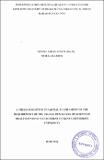| dc.description.abstract | Quality is a key principle in health service delivery a pillar in health systems strengthening. The Kenya Quality Model of health was initiated across all health facilities to guide the implementation of quality standards. The Kenya quality guidelines are guidelines for defining, measuring and improving performance of health services across different care facilities that targets organizations and clinical leaders. Despite having, guidelines there are disparities in the quality of services delivered at Kakamega County. The objectives of the study were to determine the comprehensiveness of quality guidelines implementation in Kakamega County, to establish the institutional factors of quality guidelines implementation, to establish the human resource for health factors of quality guidelines and to establish management practises of quality guidelines implementation. In a cross-sectional design, 127 clinical managers in 6 public health facilities were selected using random sampling of public health facilities, stratified and proportionate sampling of clinical managers. Data collection was through interviewer administered closed ended questionnaires and key informants schedule. SPSS version 22 was used to analyze data in frequency distributions and percentages. To determine the profile of respondents and quality guidelines implementation, institutional factors and human resource factors were analyzed using means scores, standard deviations and Anova one way. Clarity of quality guidelines had a mean score of 3.3 and objectives a mean score of 2.2. Most respondents indicated that guidelines were unavailable since most of them were kept on shelves (48%), the services that implemented the guidelines included HIV services with mean 3.7, medical services 3.6, nursing services 3.3 and pharmacy 3. The human regource for health factors that affected implementation of guidelines were awareness of guideline contents 3.7 and motivation 3. The management practices used to implement guidelines were steps in quality management with mean 3.8, planning 3.3 and use of data 3. Monitoring and evaluation was done by health workers 40 (36%) using check lists 48(40%). The findings on quality guidelines comprehensives had P-Value of 0.231 indicating no significant relationship between comprehensiveness of quality guidelines and improved health services. For institutional factors the P-value was 0.32 indicating a relationship between institutional factors and improved health services, human resource for health P-value there was 0.033 which indicated a relationship between human resource for health and improved services. Management practices P-value was 0.042 indicating a significant relationship with improved quality of health services. The study recommended formulating a policy that can be used to train human resource before implementing guidelines, sensitizing all services to implement quality guidelines and establishing strong quality teams and developing quality implementation monitoring tools. The study further recommends development of customer satisfaction feedback form to daily monitor quality of health services | en_US |

